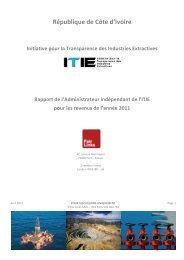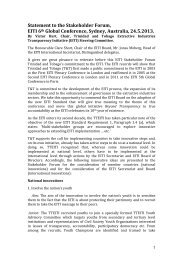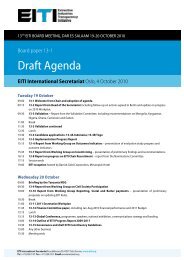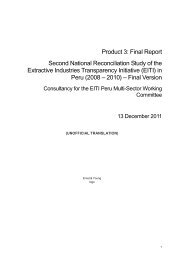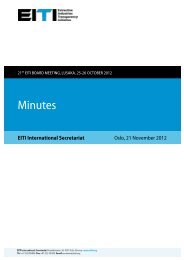EITI Business Guide
EITI Business Guide
EITI Business Guide
Create successful ePaper yourself
Turn your PDF publications into a flip-book with our unique Google optimized e-Paper software.
10 <strong>EITI</strong> BUSINESS GUIDE<br />
6<br />
7<br />
company country managers involved in any stage of <strong>EITI</strong> implementation may find<br />
this guide helpful, including those in countries whose governments have not yet<br />
signed up to the <strong>EITI</strong>.<br />
The guide has been designed for all extractive industry companies, whether large<br />
or small, whether privately-owned, publicly-traded or state-owned, and whether<br />
they extract oil, gas, or minerals. It is based on the internationally agreed <strong>EITI</strong><br />
implementation process but is structured in a numbered question-and-answer<br />
format This will help the company manager to identify the most relevant sections.<br />
How non-extractive companies can support the <strong>EITI</strong> is covered in section 12.<br />
How can my company support the <strong>EITI</strong> at the international level?<br />
The <strong>EITI</strong> is implemented at the country level, and this guide focuses mainly on how<br />
companies can support the implementation in-country.<br />
companies, however, are also encouraged to become supporters of the <strong>EITI</strong> at the<br />
international level. If your company is considering becoming an <strong>EITI</strong> supporting<br />
company, please contact the <strong>EITI</strong> International secretariat.<br />
companies that have made international commitments to support <strong>EITI</strong> should<br />
fill in an international-level company self-assessment form (see Appendix 5). They<br />
are also encouraged to make a financial contribution to the <strong>EITI</strong> International<br />
secretariat.<br />
The completed international-level company self-assessment form will be posted<br />
on the <strong>EITI</strong> international website and should be kept up-to-date. In the form<br />
companies report on their progress on supporting the <strong>EITI</strong>, including to:<br />
• publish a public statement endorsing the <strong>EITI</strong> principles and criteria (see<br />
Appendices 1 and 2) on their company website<br />
• publish completed country-level company Forms, if applicable (see Question 28)<br />
• assign the strategic responsibility for the <strong>EITI</strong> to a member of the senior<br />
management, and appoint a lead contact person.<br />
• attend or send a statement of support to the International <strong>EITI</strong> conference<br />
• Include the company’s contribution to the <strong>EITI</strong> in its corporate responsibility<br />
report.<br />
If I cannot find what I am looking for in this guide, what additional<br />
guidance is available?<br />
This guide has been designed to capture common aspects of the <strong>EITI</strong>, and provides<br />
guidance based on experience around the world. However, because<br />
implementation in each country is unique it may be necessary for companies to<br />
draw on additional guidance. Further sources of support are indicated where<br />
appropriate in the text of this document, and can be summarised as follows:<br />
• Company headquarters. If the company is an international partner of the <strong>EITI</strong>, its<br />
global headquarters will be able to provide further guidance. The company<br />
may, for example, have a global policy on the <strong>EITI</strong>. alternatively, guidance may<br />
be sought from a department responsible for external affairs or long-term<br />
political risk analysis.<br />
• The country’s Multi-stakeholder group. Most implementing countries have<br />
established a multi-stakeholder group sometimes known as a national <strong>EITI</strong><br />
secretariat, to coordinate the <strong>EITI</strong> implementation process. This group typically<br />
establishes country-specific procedures and requirements for implementation,







